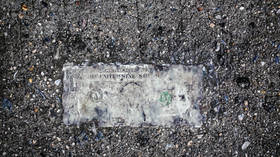
The Chinese currency has outperformed the greenback by volume of trading on the Moscow Exchange for the first time on record

© Getty Images / Yaorusheng
The Chinese yuan has overtaken the US dollar as the most traded currency on the Russian stock market for the first time ever, business daily Kommersant reported on Monday.
According to the outlet’s estimates, based on data from the Moscow Exchange (MOEX), the yuan was the most traded currency in February, displacing the US dollar from the top spot.
Statistics showed that, over the month, the volume of Chinese currency trading exceeded 1.48 trillion rubles ($19.6 billion), which is one-third higher than in January. The volume of transactions with the dollar also increased in February, but only by 8% to 1.42 trillion rubles ($18.8 billion). As a result, the yuan accounted for almost 40% of the total volume of trading in major currencies, the dollar’s share was just over 38%, while the euro stood at 21.2%. To compare, the greenback’s trading volume a year ago accounted for 87.6%, the euro for 11.9%, while the yuan for just 0.32%.
Such changes increasingly reflect Russia’s withdrawal from transactions in “unfriendly” currencies against the backdrop of expanding EU and US sanctions, Kommersant wrote.
Meanwhile, Chinese customs data shows trade turnover between Beijing and Moscow over the past year increased by 29.3%, exceeding $190 billion. About half of Russia’s trade turnover with China is in rubles and yuan, according to chief analyst at Sovcombank Mikhail Vasilyev.
READ MORE: Russia to dump euro from rainy-day fund – Finance Ministry
“Some large Russian companies have already completely switched to trading in yuan with China, some still maintain the parity of the Chinese currency with the dollar. We expect that the share of national currencies used in trade with China will increase in the coming months,” Vasilyev told Kommersant.
The business daily noted that, since the beginning of 2023, growth in the volume of exchange trading in yuan was facilitated by the fiscal rule mechanism, under which the Russian Central Bank started selling the Chinese currency on the open market in January.

Read more
“The continuing risks of Western sanctions on the Moscow Exchange and the National Clearing Center, as well as the de-dollarization policy pursued by the Bank of Russia, also contribute to the decline in demand for the currency of unfriendly countries,” Vasilyev explained.
The report pointed out that the dollar still dominates in MOEX’s trading with ‘today’ settlements, with an indicator of 0.74 trillion rubles ($9.8 billion). It is followed by the euro, with a trading indicator of 0.5 trillion rubles ($6.6 billion), and the yuan with an indicator of 0.22 trillion rubles (almost $3 billion).
Analysts explained that the mode of trading with delivery for ‘today’ is used mainly for the sale or purchase of currency as part of export-import transactions, while the mode of trading with delivery for ‘tomorrow’ is more often used, including for exchange speculation.
Chief analyst at PSB Egor Zhilnikov believes that over time the yuan will gradually become a more liquid currency against the background of both the continued de-dollarization of the Russian economy and the shift in household demand to Asian currencies. Trading volumes on the Russian stock market will rise both in the settlements for ‘tomorrow’ and ‘today,’ he predicted.
For more stories on economy & finance visit RT’s business section




